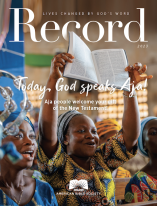Does your Church Building Engage People with the Bible?
Using architecture to share the story
Photographer/Video credits: Tyler Hiott and Gary Johnson.
In centuries past, especially before printing presses and widespread literacy, church buildings themselves were designed to illustrate Scripture. Stained glass, sculptures and murals depicted Daniel in the lion’s den, Ruth collecting wheat in Boaz’s field, and Christ walking toward Calvary. These works of art helped people relate to the stories and concepts they’d built their faith upon. Whenever they went to church, they were entering the biblical story.
Such art forms are rare in our modern churches. Maybe we’re missing an opportunity.
Can our facilities still speak the Word, and more importantly, encourage us to act on and live out what we hear and see? Of course they can.
John Jackson, principal of Jackson Galloway Associates (JGA), an architecture firm in Austin, Texas, has always made it a point to try and incorporate Scripture, either literally or symbolically, into the worship facilities his firm designs. With each project, a process of discovery reveals the vision and mission of the church. That enables the JGA team and church leaders to identify Scriptures and biblical concepts for inclusion in the facility.
At Austin Oaks Church (AOC), Jackson assigned Scripture references to 28 points on the campus, but two elements in particular stand out as tangible reminders of what we are taught in God’s Word. The first is the Narrow Gate, created to represent Matthew 7:14—“But the gate to life is narrow and the way that leads to it is hard, and there are few people who find it.” This gate, which leads into the campus’s prayer garden, was made by a metalworker in the congregation.
The Prayer Chapel windows also call the people of AOC into scriptural engagement. Within this light-filled space, four stained-glass windows communicate Romans 8:22-28 and the poignancy of the gospel story: God created us, Jesus saved us, the Spirit intercedes for us, and we are to respond with praise for the glory of God. The windows also go from crooked and chaotic shapes to perfectly symmetrical, illustrating the effects of redemption.

Similarly, the Children’s Building at First Baptist Church in Georgetown, Texas, has a larger-scale, outward-facing representation of scripture—to enter the building you must acknowledge the Alpha and the Omega. Above the entrance, metalwork forms the Greek symbol for Alpha, and the entryway itself forms the Omega. While subtle, it is an opportunity to share the truth of Christ’s eternal identity (Revelation 1:8) with everyone who enters.
At Grace Covenant Church, which sits prominently at the crossroads of two of Austin’s busiest thoroughfares (Loop 1 and U.S. Hwy 183), leaders wanted to proclaim Philippians 2:11—that Christ is Lord of all, and he’s at that intersection. JGA’s exterior design attached to the building a metalwork crown and scepter made of light poles, boldly declaring Christ’s deity. I can’t speak for the thousands of other drivers that pass it every day, but it speaks to me as I roll by—or sit still in traffic.
These examples speak to me because they put Scripture on display, which calls me to meditate on that Scripture. There are plenty of ways your church can do the same.
Start by forming a visual arts team. That’s how the concepts for the Narrow Gate and Prayer Chapel windows were realized at AOC. Most churches have artists in their congregations outside of musicians. And like musicians, those people want to use their talents to engage, encourage and edify others through the Word. Gather your artists and see what happens.
Use a lobby or multipurpose room as a temporary or rotating gallery, displaying biblical artwork. I’d suggest that you narrow the focus—not just religious art, but art that specifically connects with passages of Scripture—perhaps related to your current sermon series.This gallery can then become a space where people come for prayer, reflection, and to meditate on the Scriptures and stories portrayed in the art.
Display Scriptures on windows, walls or doors. Perhaps the simplest idea is to use inexpensive vinyl lettering, but you could also tap into the artistic and calligraphic skills of church members.
And if you’re entering a building project, take a step back to consider how the structure can embody Scripture. Don’t settle for mere functionality when the building itself could help to inspire you as a worshiping, listening, following community. A good architect will jump at the chance to bring this deeper meaning to the work.
We often teach that the “church” is not just a building; it’s the people. But if you have a building, utilizing it to its utmost is part of good stewardship. And if you desire to have a church full of people with lives built on God’s Word, why not have God’s Word built into the place where they meet?
For more views of this architect’s church designs, click here.
See a video of the Austin Oaks campus here.

Rachel Dawn Hayes
Rachel Dawn Hayes is a writer focused in the faith-based arena. She tells the stories of ministries, people, and causes she can passionately stand behind. Rachel lives in Austin, Texas, with her husband and infant daughter. As a family, they enjoy travel, the outdoors, and cooking great food for friends and family.
Thanks to the support of our faithful financial partners, American Bible Society has been engaging people with the life-changing message of God’s Word for more than 200 years.
Help us share God's Word where needed most.
Connect with our Bible engagement blog for leaders and receive a Bible-reading Habit Guide for your community.









